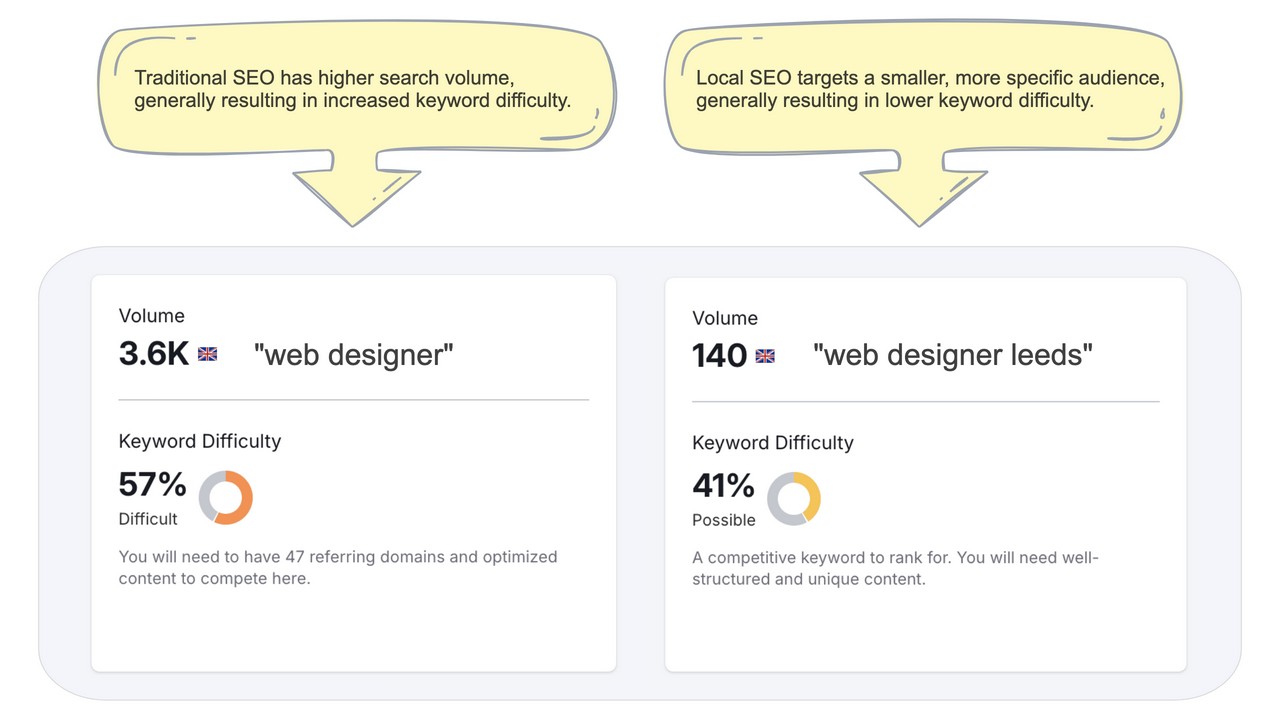Local SEO vs. Traditional SEO

Local SEO and traditional SEO each have unique strengths. Local SEO is the hometown hero, focusing on specific areas to boost visibility for brick-and-mortar shops and local services. It’s all about “near me” searches and community connections. Traditional SEO, on the other hand, is the globe-trotter, aiming for a wider audience with broader keywords. It’s perfect for online stores and national brands. Understanding these differences is essential for choosing the right strategy for your business. Let’s explore which approach will lead you to SEO success.
Key Takeaways
- Targeting Areas: Local SEO focuses on specific geographic areas, while traditional SEO aims for national or global reach.
- Search Focus: Immediate, location-specific needs are the priority for local SEO, whereas traditional SEO caters to broader search intents.
- Optimisation Priorities: Emphasis on Google Business Profile optimisation and NAP consistency is crucial for local SEO, while traditional SEO prioritises broader keyword strategies.
- Competition Levels: Competition is generally less intense in specific areas for local SEO, whereas traditional SEO competes on a global scale.
- Keyword Strategies: Local SEO relies heavily on location-based keywords and citations, whereas traditional SEO targets industry-specific terms and wider-reaching platforms.
Defining Local and Traditional SEO
At their core, Local SEO and Traditional SEO are distinct strategies within the broader field of search engine optimisation, each tailored to specific business goals and target audiences. While they share some common ground, their focus and methods differ greatly.
Traditional SEO, often called organic search optimisation, casts a wide net. It’s all about improving a website’s visibility on search engine results pages (SERPs) for a broad range of keywords. This approach is perfect for businesses aiming to reach a national or even global audience.
Local SEO is laser-focused on boosting a business’s online presence in specific geographic areas. Local search optimisation helps businesses appear in location-based queries, making it ideal for brick-and-mortar shops, restaurants, and service providers who serve local customers.
To put it simply, Traditional SEO aims to increase visibility on a global or national level, while Local SEO focuses on being discovered within a specific geographic area. Both strategies are valuable, and choosing the right one depends on your business goals and target audience.
Target Audience Differences
Geographic Focus
Local SEO’s primary distinction lies in its concentrated focus on targeting audiences within specific geographic areas, unlike traditional SEO‘s broader approach to reaching a global or national audience. This geographic targeting is the heart of local SEO, making it a powerful tool for businesses that serve customers in particular neighbourhoods, cities, or regions.
With local SEO, businesses can optimise their online presence to appear in local search results and local listings. This means when someone searches for “pizza near me” or “best dentist in [city name],” local businesses have a better chance of showing up at the top of the results. It’s like having a digital billboard right in your neighbourhood!
Traditional SEO casts a wider net. It’s great for businesses that can serve customers anywhere, like online stores or national brands. But for the local coffee shop or hardware store, it might not hit the mark.
Search Intent Variations
Beyond geographic targeting, another key distinction between local and traditional SEO lies in the search intent each approach aims to satisfy. Local SEO caters to users with immediate, location-specific needs, like finding a nearby restaurant or plumber. These searchers often want quick solutions and are ready to take action. Traditional SEO targets a broader audience, focusing on informational queries or long-term purchasing decisions.
Understanding user behaviour is essential in both cases, but the patterns differ greatly. Local searchers typically use phrases like ‘near me’ or include city names, showing their desire for proximity-based results. They’re more likely to convert quickly, often within hours or even minutes of their search. Traditional SEO users might spend more time researching, comparing options, and considering their choices before making a decision.
This difference in search intent impacts how businesses should optimise their online presence. Local businesses need to emphasise location-based keywords, customer reviews, and easy-to-find contact information. Meanwhile, traditional SEO focuses more on extensive content, building authority, and addressing a wider range of user queries.
Competition Level Differences
Examining the competitive landscape reveals significant differences between local and traditional SEO regarding target audience and market saturation. Local SEO often targets a smaller, more specific audience within a geographic area, while traditional SEO aims for a broader, sometimes global, audience. This difference in scope affects the level of competition businesses face.
For local SEO, businesses typically compete with fewer rivals, but the competition can be fierce. Keyword strategies for local SEO focus on location-specific terms, making it easier to stand out. On the other hand, traditional SEO involves competing on a much larger scale, with countless websites vying for attention.
Competitor analysis is essential in both cases, but the approach varies. Local businesses need to monitor nearby competitors and their local online presence. For traditional SEO, the competitor landscape is much broader, requiring a more extensive analysis of industry-wide trends and strategies.

Key Ranking Factors
On-Page Optimisation Differences
On-page optimisation techniques for local SEO and traditional SEO share some common ground but differ markedly in key ranking factors and implementation strategies. Both approaches rely on the strategic use of on-page keywords and well-crafted meta descriptions, but that’s where the similarities end.
For local SEO, it’s crucial to include location-specific keywords throughout your content, such as mentioning your city or neighbourhood. Also, optimising your Google Business Profile listing is essential – it’s your virtual storefront!
Traditional SEO casts a wider net. You’ll focus on broader, industry-specific keywords and creating content that appeals to a global audience.
Here’s a comparison of keyword strategies for local and traditional SEO:
| Aspect | Local SEO | Traditional SEO |
|---|---|---|
| Geographic focus | Specific locations | Broader or non-location based |
| Keyword length | Often longer | Can be shorter |
| Intent | Local services/products | General information or products |
| Competition | Usually less | Often more competitive |
| Content focus | Local relevance | General relevance |
Local-Specific Ranking Signals
Google’s algorithm for local search relies on a distinct set of ranking signals that differ from those used in traditional SEO. These local-specific factors are essential for businesses aiming to dominate the local SERPs and secure a coveted spot in the map pack (AKA the 3 pack). Understanding and optimising for these signals can significantly boost your local visibility.
Here are four key local-specific ranking signals to enhance your local SEO:
- Google Business Profile: Keep your GBP updated, accurate, and detailed.
- NAP consistency: Ensure your Name, Address, and Phone number are consistent across all local citations.
- Review signals: Encourage satisfied customers to leave positive reviews.
- Local backlinks: Build relationships with other local businesses and secure valuable local links.
Geographic Considerations
Geographic considerations are crucial in distinguishing local SEO from traditional SEO strategies. For local SEO, location relevance is key. Businesses need to focus on regional keywords that reflect their specific area of operation, incorporating city names, neighbourhoods, and even landmarks into their content and metadata.
Local SEO takes into account the physical location of your business and how it relates to potential customers. Google uses complex algorithms to determine which businesses are most relevant to a user’s search based on their location.
Traditional SEO focuses more on broader, national, or even global reach. It’s less concerned with geographic boundaries and more about general topics and keywords. For small businesses looking to attract local customers, leveraging geographic considerations in their SEO strategy is essential.
Content Strategy Variations
Crafting an effective content strategy requires distinct approaches for local and traditional SEO, with each focusing on different aspects to maximise visibility and engagement.
Topic Selection
- Local SEO: Focus on community-specific issues.
- Traditional SEO: Cover broader subjects.
Keyword Targeting
- Local SEO: Incorporate location-based terms.
- Traditional SEO: Use general industry keywords.
Content Formats
- Local SEO: Emphasise user-generated content like reviews.
- Traditional SEO: Prioritise long-form articles.
Distribution Channels
- Local SEO: Target local directories and platforms.
- Traditional SEO: Aim for wider-reaching outlets.
Measurement & Analytics Approaches
The measurement and analytics approaches for local SEO and traditional SEO differ considerably, reflecting their distinct goals and target audiences.
Conversion Tracking
- Local SEO: Focus on specific locations, like phone calls or in-store visits.
- Traditional SEO: Prioritise broader performance metrics such as organic traffic and overall website engagement.
User Behaviour
- Local SEO: Use analytics tools that highlight geographical patterns.
- Traditional SEO: Lean towards detailed reporting techniques covering a wider range of user interactions.
Campaign Optimisation
- Local SEO: Fine-tune based on location-specific factors.
- Traditional SEO: Focus on the bigger picture.
Attribution Modeling
- Local SEO: Involves both online and offline touchpoints.
- Traditional SEO: Typically has clearer online-only attribution paths.
Final Thoughts
Local SEO and traditional SEO serve different purposes but share core principles. While local SEO focuses on boosting visibility for businesses in specific geographic areas, traditional SEO aims for broader online presence. Both strategies require tailored approaches to content, keywords, and link building. The choice between local and traditional SEO depends on business goals, target audience, and market reach. Ultimately, a thorough digital marketing strategy may incorporate elements of both to maximise online visibility and drive relevant traffic.